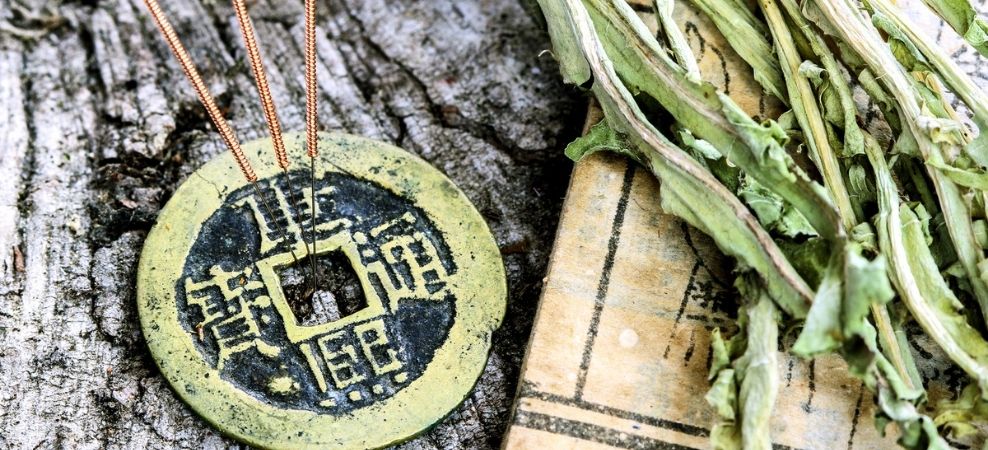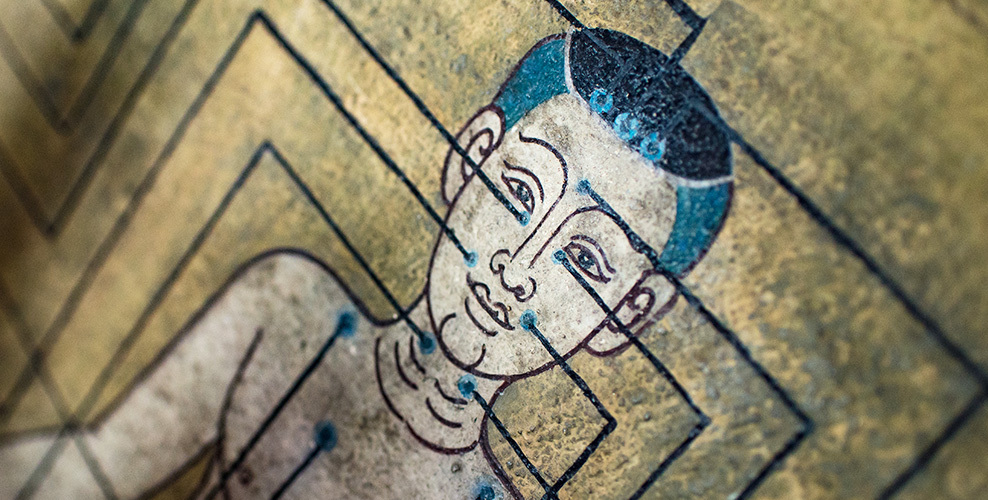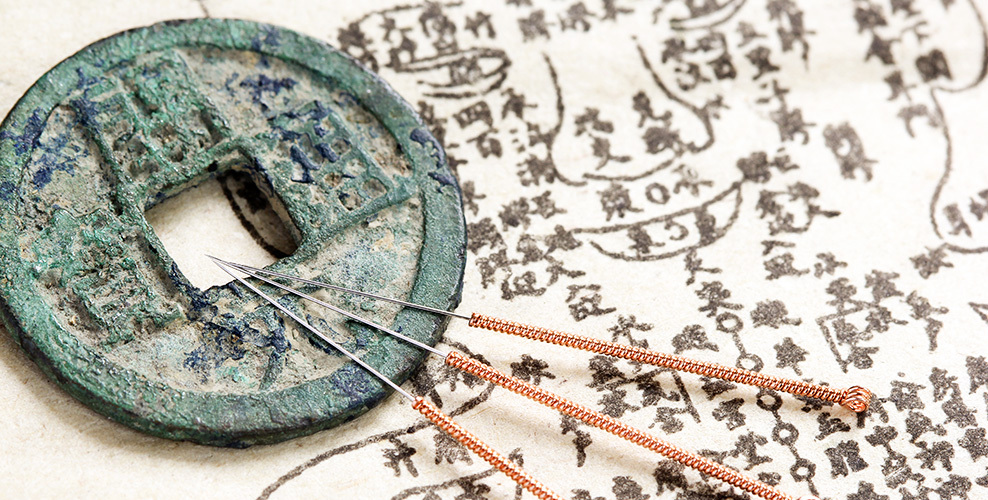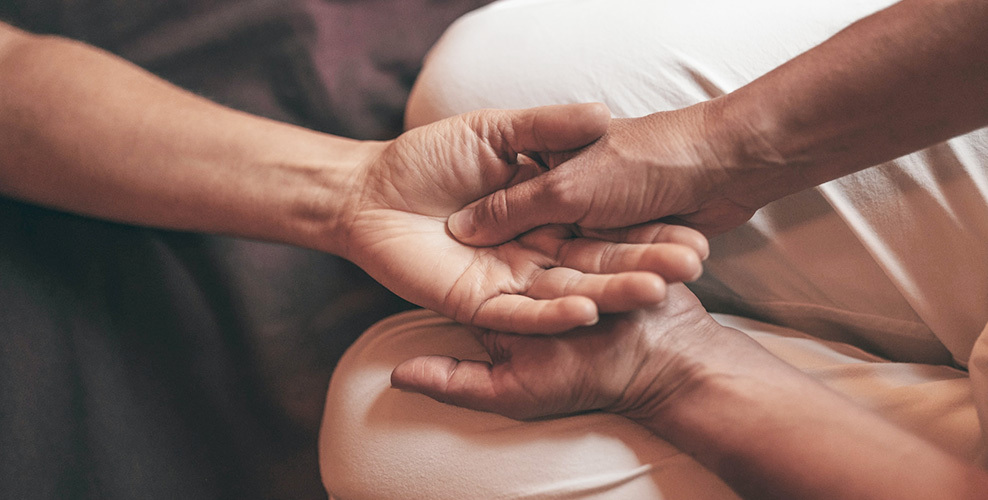What is acupuncture and how does it work?
Acupuncture has an extensive and well-respected history of use in China and other parts of Asia that spans more than 2000 years. As it becomes more and more well established in the West, many people ask, ‘How does acupuncture work?’ Keep reading to find out more about acupuncture’s fascinating history and philosophy and how it could benefit you.
Quick overview
- Acupuncture involves the insertion of fine needles into specific points of the body; their purpose is to facilitate the flow of qi or life force energy, relieving pain and helping your body to return to a state of balance and optimal function
- Acupuncture can provide symptomatic relief for a variety of conditions including hayfever, eczema, period pain, headaches and many more
- Acupressure uses your fingers and thumbs rather than needles, and can conveniently be used at home; it may relieve symptoms such as nausea, pain and stress

What is acupuncture?
Acupuncture is an aspect of TCM, a system of medicine that’s more than 2000 years old. Acupuncture is built on the foundational TCM belief that life force energy, also known as qi (pronounced ‘chee’) flows around the body through pathways, called meridians.
There are 12 principal meridians, each connecting to an organ system and extending out to an extremity like a finger or toe.[1]
Acupuncturists use a variety of tools including fine needles, or even laser or pressure, at specific surface sites of the body, called acupoints, to help redirect the flow of energy when it has been disrupted in some way.[1]
The five elements and acupuncture
The five elements theory is one of the central concepts in TCM. These elements (wood, fire, earth, metal and water) are all connected and are associated with different body organs and emotions. Finding a balance between all five elements is the key to attaining an ideal state of health, according to TCM philosophy.
How does acupuncture relate to the five elements?
Dominance or weakness of one element can lead to imbalance in the other four elements, including stagnation or too much energy flow to the related area or areas of the body, which in turn can result in physical symptoms and discomfort.
Acupuncture can help to rebalance any such elemental imbalances to alleviate related physical symptoms and dysfunction.
Are you wondering which element is dominant for you and your health right now? Find out by taking our short quiz here.

When was acupuncture invented?
The Chinese emperor Huang Di is credited with inventing acupuncture in around 2500 B.C. – but considering he was also believed to be responsible for developing both agriculture and written language, we might take this with a grain of salt!
It’s likely that acupuncture developed through massage, with noticeable points being tender and in need of stimulation. From this, wooden sticks or early acupuncture instruments made of stone were initially used to enhance the effects of massage and get deeper into the muscles. But wooden sticks had their limits, so finally a more precise method was settled on: needles that would stimulate the tender point without causing damage to the surrounding skin. This leads us to the present form of acupuncture, where qualified acupuncturists target specific acupoints to bring relief to their patients for a variety of conditions.
How does acupuncture work?
A trained acupuncturist targets acupoints, found along meridians running along the surface of the body, to help redirect and improve the flow of energy to the associated organs and body parts.
In addition to using needles, acupuncturists may also direct the flow of qi and blood to the relevant areas by using laser, moxibustion (in which a smoking stick of mugwort is held near the skin to draw blood flow and qi to the area), cupping (in which small cups are applied with pressure to the certain points on the skin to encourage qi and blood to circulate to the area) or pressure. Patients experience relief from certain symptoms and conditions once the energy flow along the meridian is improved.[1]
A common misconception related to acupuncture is that it must be painful because it uses needles. In fact, acupuncture is minimally invasive. The needles used are extremely fine and many people either don’t notice them being inserted or feel only mild and momentary discomfort as the acupoint is stimulated, followed by relaxation.

Benefits of acupuncture
Here are just a few of the many conditions acupuncture can help provide relief from.
Acupuncture for hayfever
The itchy eyes and runny nose of hayfever is no fun for anyone, so it’s no surprise sufferers are always on the lookout for anything that will provide relief. In a review of 13 studies, acupuncture was found to provide effective relief from the symptoms of hayfever by supporting the immune system.[2]
Acupuncture for eczema
Acupuncture has been found to soothe the itching associated with eczema in a review of multiple studies.[3] Another showed that acupuncture positively influenced the brain circuitry in eczema sufferers, reducing the habitual urge to scratch, which can damage the skin and worsen the condition.[4]
Period pain and acupuncture
The results of a review of 60 studies showed that acupuncture treatment used for period pain was more effective at reducing pain than no treatment. The pain-relieving results of acupuncture can be maintained with follow-up sessions.[5]
Acupuncture for headache and migraines
For anyone suffering from headaches or migraines, acupuncture can bring great relief.[6] A 2018 study found that acupuncture both decreased pain and also reduced the frequency of headaches.[7]
Muscle tension and joint pain
Whether you’re a weekend warrior, a constant worrier or a work-from-homer, muscle tension is a common complaint. Acupuncture can provide short-term pain relief for musculoskeletal complaints like mild lower back pain and mild knee osteoarthritis.[8]
Acupuncture for morning sickness
Although morning sickness mostly impacts women in the first trimester, for some it can linger through the entire pregnancy. Acupuncture is both safe and effective at relieving morning sickness.[9] At home, acupressure can also help to ease nausea and vomiting in pregnant women by using the inner wrist acupoint, nei guan.[10]
How to find your nearest acupuncturist
Regular or one-off sessions of acupuncture are not only beneficial, but are something you can look forward to. Your acupuncturist will take a detailed health history and create an individualised treatment just for you. Then all you have to do is chill out and relax – since one of the benefits of acupuncture is relaxation!
To find your nearest acupuncturist, head to the Natural Therapy Pages and click on your local area.

Acupressure at home – DIY tips
Acupressure uses the same principles and acupoints as acupuncture. Both can have amazing benefits; the difference being that acupressure doesn’t use needles. The main benefit of acupressure is that you can do it yourself from the comfort of your own living room.
You can try acupressure at home on yourself or a loved one for quick, effective relief from a variety of symptoms. The benefits include pain relief, relief from nausea or vomiting, improved energy levels, and stress reduction.[11]
Using just your fingers (commonly the middle finger, index and/or thumb), put firm pressure on acupoints to manipulate the meridians and energy flow. The point might feel tender to touch, but don’t use so much pressure that it’s painful. Hold each point until you feel relief, or for about 5 minutes.
Here are a few useful acupressure points:
- Applying pressure to the hegu point in between the thumb and index finger can bring relief from headaches, pain and digestive upset. TOP TIP: this point is contraindicated in pregnancy, except under the guidance of your acupuncturist.
- The nei guan pressure point just below the inner wrist helps with nausea and can even help with travel sickness.
- If you’re looking for stress-reduction techniques, the acupressure point yin tang could be for you. This point is easy to find since it’s right between the eyebrows.
Fun facts about acupuncture
- Although many people still refer to acupuncture as ‘alternative medicine’ in the Western world, it’s been an established form of medicine for thousands of years in China and other parts of Asia.
- Around 1 in 10 Australians have received acupuncture – it’s been used in the country since at least the 1850s when it was introduced by the first wave of Chinese immigrants [12]
- Acupuncture and TCM are used alongside Western medicine in the Chinese healthcare system. In fact, more than 90% of Chinese hospitals have a TCM department [13]
We hope we’ve given you some insight into what acupuncture is and how it works, and that you’re now keen to give it a try if you haven’t already.
References:
- Maurer N, et al. Evidence-Based Complementary and Alternative Medicine 2019; 6976892.
- Feng S, et al. Am J Rhinol Allergy 2015;29(1):57-62.
- Akpinar R, et al. International Journal of Allergy Medications 2018;4(2).
- Napadow V, et al. Cereb Cortex 2014;24(4):873-882.
- Woo HL, et al. Medicine (Baltimore) 2018;97(23):e11007.
- Jiang Y, et al. Front Pharmacol 2018;9:1190.
- Mayrink WC, et al. J Acupunct Meridian Stud, 2018;11(5):296-302.
- Zhang Y, et al. Current Rheumatology Reports 2020;22(11):80.
- Pregnancy, Birth & Beyond. Last updated October 2020, accessed July 2021 from https://www.pregnancy.com.au/acupuncture-beats-morning-sickness/
- Tara F, et al. Complement Med Res 2020;27(4):252-259.
- WedMD. Last updated October 2019, accessed July 2021 from https://www.webmd.com/balance/guide/acupressure-points-and-massage-treatment
- Xue CC, et al. Chinese Medicine 2009;4(7).
- Xu J. Health Policy 2009;90(2):133–139.



















